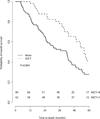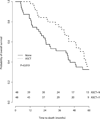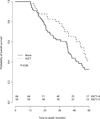High-dose therapy and autologous stem cell transplant in older adults with multiple myeloma
- PMID: 25961765
- PMCID: PMC4526374
- DOI: 10.1038/bmt.2015.106
High-dose therapy and autologous stem cell transplant in older adults with multiple myeloma
Abstract
Randomized trials showing that high-dose therapy with autologous stem cell transplant (ASCT) improved the overall survival (OS) in multiple myeloma (MM) excluded patients over age 65. To compare the outcomes of older adults with MM who underwent ASCT with non-transplant strategies, we identified 146 patients aged 65-77 with newly diagnosed MM seen in the Washington University School of Medicine from 2000 to 2010. Survival among patients who did (N=62) versus did not (N=84) undergo ASCT was compared using Cox proportional hazards modeling, controlling for comorbidities, Eastern Cooperative Oncology Group performance status (PS) and the propensity to undergo ASCT. Median age was 68 years (range 65-77). PS and comorbidities did not differ significantly between those who did versus those who did not undergo ASCT. Median OS was significantly longer in patients who underwent ASCT than in those who did not (median 56.0 months (95% confidence intervals (CIs) 49.1-65.4) versus 33.1 months (24.3-43.1), P=0.004). Adjusting for PS, comorbidities, Durie-Salmon stage and the propensity to undergo ASCT, ASCT was associated with superior OS (HR for mortality 0.52 (95% CI 0.30-0.91), P=0.02). In a cohort of older adults with MM, undergoing ASCT was associated with a nearly 50% lower mortality, after controlling for PS, comorbidities, stage and the propensity to undergo ASCT.
Conflict of interest statement
Conflict of Interest
The authors have no relevant conflicts of interest.
Figures
References
-
- Smith BD, Smith GL, Hurria A, Hortobagyi GN, Buchholz TA. Future of Cancer Incidence in the United States: Burdens Upon an Aging, Changing Nation. Journal of Clinical Oncology. 2009;27(17):2758–2765. - PubMed
-
- Kyle RA, Gertz MA, Witzig TE, Lust JA, Lacy MQ, Dispenzieri A, et al. Review of 1027 patients with newly diagnosed multiple myeloma. Mayo Clin Proc. 2003;78(1):21–33. - PubMed
-
- Klepin HD, Hurd DD. Autologous transplantation in elderly patients with multiple myeloma: are we asking the right questions? Bone Marrow Transplantation. 2006;38(9):585–592. - PubMed
Publication types
MeSH terms
Grants and funding
LinkOut - more resources
Full Text Sources
Other Literature Sources
Medical





